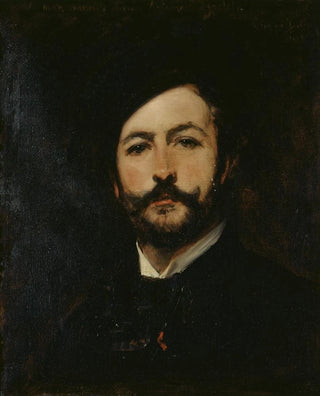Portrait of Baron Antoine d'Ezpeleta - Carolus-Duran | Art print


View from behind

Frame (optional)
At the heart of art history, some works stand out for their ability to capture not only appearance but also the very essence of their subjects. "Portrait of Baron Antoine d'Ezpeleta - Carolus-Duran" is one of these masterful pieces that transcends a simple portrait to become a true window into the soul of the model. Created by Carolus-Duran, a master of 19th-century portraiture, this painting evokes an era when art served as a mirror to society, while celebrating the individuality of its characters. Baron d'Ezpeleta, an emblematic figure of his time, is depicted with such finesse that every detail seems to tell a story, inviting the viewer to immerse themselves in the aristocratic and elegant universe of 19th-century France.
Style and uniqueness of the work
The piece is distinguished by its impressive style and refined technique. Carolus-Duran, known for his ability to blend realism and impressionism, manages to create a unique atmosphere that envelops the viewer. The treatment of light, for example, is of remarkable subtlety. Delicate shadows and luminous reflections reveal not only the texture of the baron's clothing but also the depth of his character. The colors, carefully chosen, oscillate between warm tones and darker shades, creating a contrast that emphasizes the presence of the model. Every brushstroke seems charged with emotion, and the expression of the baron, both stoic and engaging, challenges anyone who dares to meet his gaze. This portrait is not merely a visual representation; it is a psychological exploration that echoes the concerns of its time.
The artist and his influence
Carolus-Duran, whose real name is Charles Émile Duran, is an essential figure in the 19th-century art world. Trained at the École des Beaux-Arts, he distinguished himself through his innovative technique and bold approach to portraiture. As a teacher and mentor, he also influenced many artists, some of whom would become major figures of Impressionism. His style, which combines academic rigor

Matte finish

View from behind

Frame (optional)
At the heart of art history, some works stand out for their ability to capture not only appearance but also the very essence of their subjects. "Portrait of Baron Antoine d'Ezpeleta - Carolus-Duran" is one of these masterful pieces that transcends a simple portrait to become a true window into the soul of the model. Created by Carolus-Duran, a master of 19th-century portraiture, this painting evokes an era when art served as a mirror to society, while celebrating the individuality of its characters. Baron d'Ezpeleta, an emblematic figure of his time, is depicted with such finesse that every detail seems to tell a story, inviting the viewer to immerse themselves in the aristocratic and elegant universe of 19th-century France.
Style and uniqueness of the work
The piece is distinguished by its impressive style and refined technique. Carolus-Duran, known for his ability to blend realism and impressionism, manages to create a unique atmosphere that envelops the viewer. The treatment of light, for example, is of remarkable subtlety. Delicate shadows and luminous reflections reveal not only the texture of the baron's clothing but also the depth of his character. The colors, carefully chosen, oscillate between warm tones and darker shades, creating a contrast that emphasizes the presence of the model. Every brushstroke seems charged with emotion, and the expression of the baron, both stoic and engaging, challenges anyone who dares to meet his gaze. This portrait is not merely a visual representation; it is a psychological exploration that echoes the concerns of its time.
The artist and his influence
Carolus-Duran, whose real name is Charles Émile Duran, is an essential figure in the 19th-century art world. Trained at the École des Beaux-Arts, he distinguished himself through his innovative technique and bold approach to portraiture. As a teacher and mentor, he also influenced many artists, some of whom would become major figures of Impressionism. His style, which combines academic rigor
12,34 €






